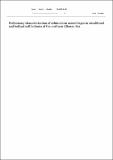Por favor, use este identificador para citar o enlazar a este item:
http://hdl.handle.net/10261/320329COMPARTIR / EXPORTAR:
 SHARE
BASE SHARE
BASE
|
|
| Visualizar otros formatos: MARC | Dublin Core | RDF | ORE | MODS | METS | DIDL | DATACITE | |

| Título: | Preliminary characterization of echinoderm assemblages in circalittoral and bathyal soft bottoms of the northern Alboran Sea |
Autor: | Moya-Urbano, Elena; Moya-Ruiz, Francisca; Mateo-Ramírez, Ángel CSIC ORCID; Gallardo-Núñez, Marina; Ordines, Francesc; Farias, Carlos CSIC ORCID; Manjón-Cabeza, María Eugenia; Urra, Javier; Rueda, José Luis; García-Ruiz, Cristina | Palabras clave: | Alboran Sea Centro Oceanográfico de Málaga Medio Marino echinoderms assemblages distribution Biodiversity Soft bottoms |
Fecha de publicación: | 3-sep-2016 | Citación: | XIX Iberian Symposium on Marine Biology Studies. (05/09/2016 - 09/09/2016. Porto (Portugal)). 2016. 10.3389/conf.FMARS.2016.05.00102. En: Frontiers in Marine Science, . | Resumen: | Echinoderms, with 7.272 species described so far (based on WORMS), provide an ecosystemic role which can be important depending on their habitat, and including tag species (Manjón-Cabeza et al., 2014; Palma-Sevilla 2015) or even dominant ones (Iken et al., 2010; Hughes et al., 2012). Despite the increasing knowledge on their taxonomy, studies on ecological and assemblage composition and structure of echinoderms are very scarce compared to those for other invertebrate groups, being this information essential for improving the knowledge on Mediterranean ecosystems (Coll et al., 2010). The Alboran Sea, in the junction of the Atlantic Ocean and the Mediterranean Sea and the European and African continental margins, represents a biodiversity hotspot due to the overlapping of species from those basins and continents, including some endemic components (Coll et al., 2010). Regarding echinoderms of the Alboran Sea, most previous studies focussed on infralittoral bottoms, with very few for circalittoral and bathyal ones (Manjón-Cabeza et al, 2014; Sibuet, 1974). Nevertheless, these studies generally included faunistic lists (Ocaña & Pérez-Ruzafa, 2004; Manjón-Cabeza et al., 2014), sometimes with identification keys, ecological and distributional data of some species and rarely on the assemblage composition and structure (Palma-Sevilla, 2015), which represent the main aim of this study on echinoderm assemblages of circalittoral and bathyal soft bottoms of the Alboran Sea. During the MEDITS survey expeditions (April-May 2014-2015) on board the R/V Miguel Oliver (Fig. 1), 35 samples were collected using a beam trawl (horizontal and vertical openings of 1.3 and 1.2 m, respectively, and a mesh size of 10 mm in the codend) at depths from 40 to 774 m in the Alboran Sea (Fig. 1). Hauls were done at a speed of ca. 2 knots during 5-10 (shelf stations) and 15 minutes (slope stations). Echinoderms were separated, identified to the lowest possible taxonomic leveland specimens counted and weighed to the nearest 0.5 g. Abundance and biomass data were standardized to 1000 m2 according to the sampling area of each haul. Echinoderm assemblages were characterized according to the dominance and frequency of occurrence of species in the samples and considering different ecological indexes. Multivariate methods (CLUSTER, nMDS, SIMPER, ANOSIM) were applied, based on the Bray & Curtis similarity index, for detecting and contrastingassemblages in relation to depth and 4 geographic areas of the Alboran Sea with different influence of Atlantic waters (Occidental-Esteponato Málaga, Central-Málaga to Motril, Oriental-Motril to Almería and Alboran Island). Fig. 1. Location of beam-trawl samples (dots) collected during 2014 and 2015 MEDITS expeditions in the northern Alboran Sea. At present 39 taxa have been detected, mostly belonging to Ophiuroidea and Asteroidea (28.2 and 25.6% of all species, respectively), followed by Holothuroidea (23.1%), Echinoidea (17.9%) and Crinoidea (5.1%). Regarding abundance, a total of 54689 individuals have been collected, being Ophiuroidea (98.6% of all individuals), Holothuroidea (0.6%) and Crinoidea (0.4%) the top-dominant classes. Regarding biomass, ophiuroids also dominated (52.8%), followed by asteroids (16.1%) and holothuroids (15.0%). Considering other faunistic groups, echinoderms were the most abundant phyllum in the samples (60.7%) and the fifth one in biomass (7.6%). The dominant (for both abundance and biomass) and frequent genera included Ophiocten (displaying dominances >90%) Hymenodiscus, Luidia and Astropecten for asteroids, Antedon and Leptometra for crinoids, Dendrochirotida and Molpadidae for holothuroids, and Brissopsis and Echinocyamus for echinoids (Fig. 2). Fig. 2. Some echinodermscollected in circalittoral and bathyal soft bottoms of the Alboran Sea using beam-trawl during the MEDITS expeditions. A: Ophiocten; B: Dendrochirotida sp.; C: Brissopsis; D: Anseropoda; E: Luidia. Multivariate analyses indicated groupings of samples and significantly different echinoderm assemblages in relation to depth (RANOSIM=0.22, p<0.005), but not between sectors of the Alboran Sea (RANOSIM=0.13, p>0.05). Shelf assemblages displayed lower intra-group similarities (<20% similarity in SIMPER) than the slope ones (ca. 40%). Species characterizing the shelf assemblages belonged to the genera Astropecten, Antedon, Ophiothrix among others, whereas those of the slope belonged to the genera Luidia (L. sarsi), Hymenodiscus, Ophiocten, Leptometra and Amphiura. | Versión del editor: | http://www.frontiersin.org/10.3389/conf.fmars.2016.05.00102/event_abstract | URI: | http://hdl.handle.net/10261/320329 |
| Aparece en las colecciones: | (IEO) Comunicaciones congresos |
Ficheros en este ítem:
| Fichero | Descripción | Tamaño | Formato | |
|---|---|---|---|---|
| Moya-Urbano et al_2016_Preliminary characterization of echinoderm assemblages in circalittoral and bathyal soft bottoms of the northern Alboran Sea_ABSTRACT PUBLISHED.pdf | Resumen publicado | 92,97 kB | Adobe PDF |  Visualizar/Abrir |
CORE Recommender
Este item está licenciado bajo una Licencia Creative Commons



